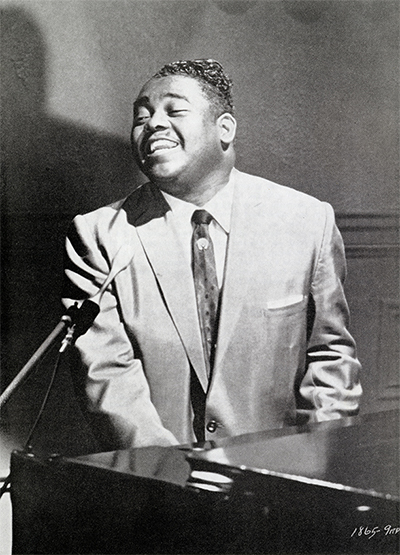“They call, they call me the fat man
Because I weigh two hundred pounds
All the girls they love me
'Cause I know my way around”
With these words, Fats Domino hit the rhythm and blues scene running. These are the lyrics from Domino's “The Fat Man,” his first record and an instant hit in the New Orleans area. Fats Domino was playing piano and singing at the Hideaway, a small club in the city, where Imperial Records owner Lew Chudd signed him after hearing a single set. Domino was in the recording studio shortly after.
Fats Domino went on to record and tour extensively as he rose from local popularity to become a national star. His music blended regional idioms of New Orleans with national musical trends, and his story exemplifies the inner workings of making R&B in the 1950s. This exhibit explores Domino's multifaceted career: his music, his reception, and his legacy.
Walking to New Orleans is drawn from the Wouter Keesing Collection on Fats Domino and New Orleans R&B, housed in University of Maryland's Special Collections in Performing Arts. Click on images to view the documents, pictures, and records more closely.
Slider Credits: Walking to New Orleans: The Wouter Keesing Collection on Fats Domino: Photos of Fats Domino, undated. The Music of Fats Domino: Left, “Be My Guest / “I’ve Been Around” record insert, 1959. Right, sheet music for “Blueberry Hill,” c. 1960s. The Industry of New Orleans R&B: Left, photo of Fats Domino performing, undated. Right, Imperial 45 RPM single sleeves, 1951–64. The New Orleans R&B Scene: Left, Wavelength magazine cover, no. 17, March 1982. Right, Fats Domino t-shirt featuring Opal Louis Nations drawing, undated. The Legacy of Fats Domino: Left, Billboard ad, from Galen Gart, First Pressings: The History of Rhythm & Blues – Volume 7: 1957. Milford, N.H.: Big Nickel Publications, 1993. Right, cover from Best of the Blues set of 45 RPM singles. The Keesing Collection: Left, Wouter Keesing going through 45 RPM singles, photographed by a member of the Keesing family, undated. Right, Special Collections in Performing Arts boxes, photographed by Vincent Novara.







